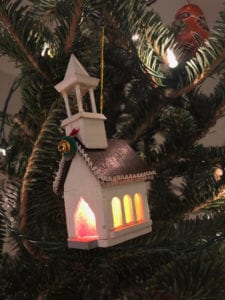Introduction
Okay, let’s get this straight – this is not a “Bah, humbug!” blog post. I love Christmas! And I love Jesus! And I love celebrating Christmas with my family and church. But I ran across something just recently that got me to thinking.
Like the rest of you, I’ve spent some of the last week pulling Christmas decorations down from the attic — the nativity scene of terra cotta figures, table decorations, fireplace mantel greenery, lights and lights and lights, and then the buying and raising of the family Christmas tree, which means for us lots and lots of Christmas tree ornaments.
Now I don’t know about you, but my household is 38 years young. And I feel sure that we have at least one ornament either made or purchased for every year. For some years, maybe there are eight or ten. Let’s just say that the Carrolls will not run out of ornaments anytime soon. In fact, we have so many that we could probably decorate at least two and maybe three Christmas trees! We still have the first ornament from our first year of marriage. We have the ornament that each of our kids made in school – you know the one – the one with the school picture in it. We have the olive wood ones from Israel, the clear glass ornament from the Finnish exchange student, the little church that you put a light in, the Tin Man (since ONE of us played the role in his high school musical – yikes!), the wooden one with the emblem of my favorite camp, and on and on and on, to the extent that there are two boxes left when the Christmas tree is full!


So many memories… so many years… SO MANY… PERIOD!
The question becomes, “How do you let things go that over the years have had so much meaning, that tell the story of our lives, and that have become a part of the tradition that defines who we are, even when we are overrun with them?”
The answer is – “You don’t… except…”
Before I go on, you already know that I’m not just talking about Christmas ornaments. While we all must one day sort through a plethora of too many Christmas ornaments, we also run into this same question (and answer) when it comes to our churches and ministries. How do we deal with the traditions of our ministries, some which are decades even centuries old, particularly when we know we have too many?
You Don’t Let a Tradition Go… Except…
- WHEN YOU JUST HAVE TOO MANY – This usually shows up in a ministry calendar that is overcrowded, a staff that is over-stressed and/or burned out, and church members that are complaining about the number of times they are driving to the church. One of the worst things that we can do is to over-schedule our ministries. We don’t really mean to do that, but sometimes we have the tendency to think that more is always better. But more is not always better. BETTER is better. If your ministry’s calendar is leading you toward exhaustion, especially at a time like Christmas, it might be a good time to evaluate the kind of time commitment you are expecting from your ministry participants and work to make sure that the time they spend with you is of the highest quality.
- WHEN THE TRADITION IS BROKEN – How do you tell when a tradition is broken? It doesn’t do what it was intended to do. Take Advent for example. Some churches observe the Advent tradition as a way to prepare for the celebration of the birth of Christ. Many find it to be a meaningful practice. But for some, Advent just becomes a reason to get Sunday School Christmas parties on the calendar or a chance to sell the most recent church cookbook. Sometimes traditional youth retreats lose their real purpose, too. And what began as an event that brought young people into a deeper walk with God, becomes “that retreat where we always walk that trail with candles.”
- WHEN THE TRADITION IS EMPTY – If you’ve ever “gone through the motions” (oh yeah, I guess that’s probably all of us if we’re honest), then you know what an empty tradition looks like. You remember the story about the Danish church that had the funny little tradition? Everyone would stop and bow whenever they passed down the side aisle at this one particular spot. When asked why, they didn’t really know. They just did it. It wasn’t until a number of years later, as they were cleaning the whitewashed interior walls that they made a discovery. As they were washing the wall at that spot, an image began to appear. The more they washed, the more was revealed. At that spot had been a beautiful painting of the Madonna and Child. Now they could bow… and know why. Sometimes that is what happens to our traditional events – we do things but we don’t know why. My suggestion? Either find a real reason to keep a tradition, or scrap it.
- WHEN THE TRADITION IS OUT OF STEP WITH THE CURRENT VISION – From time to time we evaluate the vision for our ministries. Sometimes that vision changes, and that becomes precisely the time to evaluate our ministry elements to determine if they are truly in step with the evolving vision. For example, a youth ministry vision with an emphasis on youth leadership should never sponsor an event in which youth have not played an important role in planning, implementing, and leading. Or a church with a high emphasis on scripture should never host a Vacation Bible School at which the scripture is never read. You get it. Sometimes traditions just hang around for a long time, whether they really fit or not.
Conclusion
I’ll say it again – I love Christmas! It is one of only two high holy seasons in the life of the Church. It isn’t broken. It isn’t empty. It is right in line with who we are and who we want to be as Christians – a people who celebrate Christ and His Birth.
And those Christmas ornaments? Well, I can toss out the broken ones, and I can cull through the rest to make sure they really fit. But they help tell the story, so I think I’ll keep them around, even the Tin Man, because those children, whose pictures hang on our tree, now have homes of their own. And they will want to tell the story, too. That’s a tradition we’ll keep and a legacy we will pass on to them.
May all the joys and blessings of Christmas be yours!

